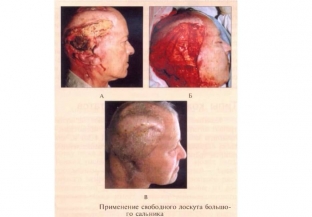Skin flaps are widely used in modern plastic surgery. Thanks to this method, it became possible to close large wounds and defects with the body's own tissues. The main advantage of using skin flaps over grafts is that the blood supply to the graft is maintained, which helps to some extent to prevent rejection. To date, not only areas of the dermis and epidermis are transplanted, but also deep-lying tissues: muscle flaps, musculocutaneous flaps and flaps from the greater omentum are used. More about them tells estet-portal.com.
How muscle flaps are formed for transplantation in plastic surgery
In the past few decades, the choice of methods for reconstructing different parts of the human body has expanded significantly. In addition to the usual skin-fat flap, which has almost two thousand years of history, muscle flaps, flaps & nbsp; from the greater omentum, covered with skin graft, musculocutaneous flaps, and so on. These flaps are fed by the axial artery, whereby they can be significantly lengthened without the threat of necrosis. The use of such flaps makes it possible to close many deep defects in different parts of the patient's body.
Patches:
- features of the formation and transplantation of muscle flaps;
- features of the use of flaps from the greater omentum;
- how musculocutaneous flaps are used in plastic surgery.
Features of the formation and transplantation of muscle flaps
Muscle flaps are transplanted on a neurovascular pedicle to nearby recipient sites and covered with a skin graft. With the help of such long flaps, it is especially good to reconstruct the trunk and lower limb. Donor flaps are formed, most often, from the following muscles:
- calf muscle – musculus gastrocnemius;
- thin muscle – musculus gracilis;
- tensor of the wide fascia of the thigh – musculus tensor fasciae latae;
- soleus muscles – musculus soleus;
- finger flexor long – musculus flexor digitorum longus.
With the help of muscle flaps, it is possible to close large acute post-traumatic defects with exposed metal structures and bone structures in the shortest possible time – up to 5 days. Thus, it is possible to prevent the development of the inflammatory process and ensure wound healing by primary intention.
Features of the use of greater omental flaps
Flaps from the greater omentum, covered with a skin graft, are used to close wounds on the chest wall, in the armpits, and exposed carotid arteries. Due to the high plasticity of the omentum, it is possible to close defects of the head and limbs that are complex in shape. A flap from the greater omentum can be transplanted extraperitoneally and closed with a split skin graft. There are three main ways to lengthen such flaps:
- separation from the transverse colon – as a result of this, the length of the flap can be increased by 2-12 cm;
- separation from the stomach with ligation of the gastroepiploic arteries – while the omentum can reach the angle of the sternum;
- separation of the omentum near the middle of its attachment to the stomach – in this case, the omentum may reach the cranial vault.

How musculocutaneous flaps are used in plastic surgery
Muscocutaneous flaps consist of muscles with overlying skin. Such flaps are used to reconstruct completely different parts of the patient's body, especially to close defects in the lower limb. Due to the mobilization of the legs of the musculocutaneous flaps, their numerous perforating arteries provide sufficient blood supply to the skin covering the muscle. Depending on the characteristics of the blood supply, the musculocutaneous flaps can be divided as follows:
- flaps on one vascular pedicle;
- flaps with one dominant pedicle and one non-dominant pedicle, which cannot ensure the survival of the entire grafted flap;
- flaps on two dominant legs;
- flaps with segmental origins;
- flaps that have one dominant pedicle and a number of segmental pedicles that can ensure the survival of the flap.







Add a comment